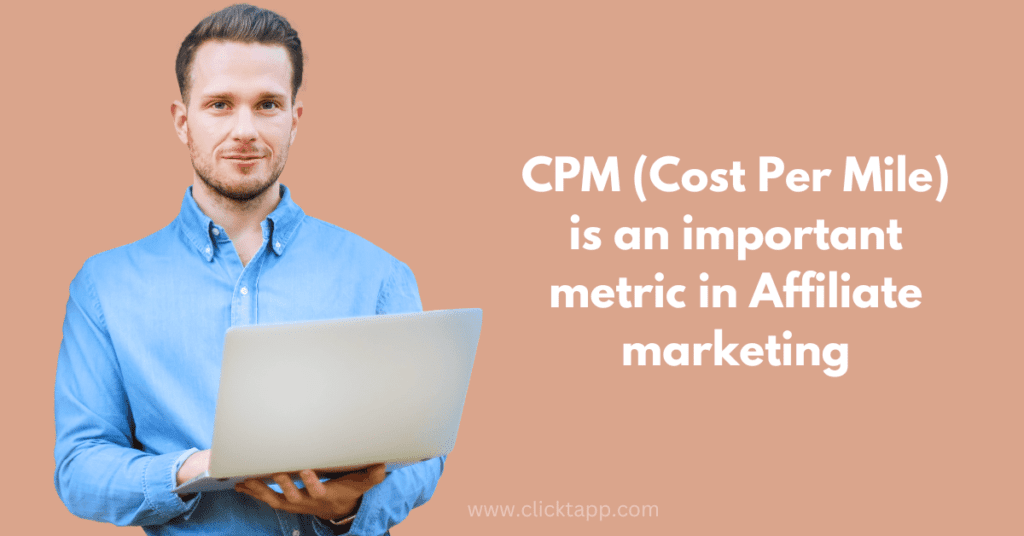CPM (Cost Per Mile): Affiliate and Performance Marketing Uses
CPM (Cost Per Mile) is a key metric in digital marketing. It helps advertisers, affiliates, and platforms see their ads’ value. knowing CPM is crucial for affiliate and performance marketing. This analysis looks at CPM. It is important to know how to use it and its future.

Understanding CPM (Cost Per Mile) in Affiliate and Performance Marketing
CPM, or cost per thousand impressions, is a key advertising metric. It measures the cost of showing an ad to a thousand people. It is not the same as CPC (cost per click) and CPA (cost per acquisition). They focus on what people do after seeing the ad. For example, take a billboard on a busy highway. With CPM, you pay for ad views. You also pay for product buys or website visits. This method shows how far ads reach, but not the feedback. For example, a company might use CPM to kick off a new product. They want to show their brand to as many people as possible, no matter the conversion rate.
The Role of CPM (Cost Per Mile) Marketing Landscape
Traditional advertising methods and advanced technologies merge digital marketing environment. In this context, CPM remains relevant for several reasons:
1. CPM is key for brand visibility campaigns. It’s useful even without immediate sales. It helps advertisers see how far their message reaches.
2. CPM has a clear pricing model. This helps advertisers stick to their budgets, especially on popular sites or platforms.
3. Performance Benchmarking lets advertisers compare CPM rates across channels. It is a useful tool. This helps them check their marketing. Then, they can improve strategies for a better return.

Strategic Uses of CPM in Affiliate Marketing
Advertisers and affiliates in affiliate marketing can use CPM to benefit through partnerships:
1. Publishers or affiliates with high-traffic websites can make money via CPM ads. It gives them a steady income based on their site’s views.
2. Affiliates can use CPM data to make better choices. It shows them the most profitable content and platforms. This way, they can earn more by focusing on those areas.
3. Affiliates can check CPM in different channels. This helps them build a strategy that uses many channels. The strategy enhances visibility and engagement. It may lead to more conversions.

CPM in Performance Marketing: A Deep Dive
Performance marketing focuses on tangible results, such as clicks, conversions, and sales. Within this realm, CPM serves many purposes:
1. Marketers can use CPM-based campaigns to test the market and find insights. They can first study audience behavior and preferences. This way, they avoid costly CPC or CPA ads.
2. CPM campaigns can work well with CPA or CPC models. They boost awareness, which in turn raises conversion rates and lowers acquisition costs.
3. For remarketing, CPM lets brands stay cheap in front of bounced traffic. It keeps the brand top of mind when consumers are ready to buy.
Future Potential of CPM
As we look ahead, the potential of CPM continues to evolve. It’s evolving in affiliate and performance marketing. It’s changing with technological advancements and market trends:
1. Algorithms predict how users will respond to ads. Then, they adjust the messages to be more effective. AI tweaks ads on the spot. Marketers then target specific groups. This makes campaigns work better.
2. Programmatic advertising platforms are on the rise. They aim to boost the efficiency and targeting of CPM campaigns. These platforms automate the buying and selling of ads. They enable precise targeting and real-time bidding. This can lead to lower CPM rates.
3. Advertisers will be able to track and report more on impressions. We aim to boost transparency and prevent fraud using blockchain technology. This will cut down ad fraud and make CPM metrics more reliable.
4. Measurement standards are changing. They now focus on impressions that are both seen and engaged with. This update makes CPM more useful and accurate for advertisers and affiliates. As a result, they get better insights into how ads perform.

Conclusion
In 2024, CPM will be a key measure in affiliate and performance marketing. Brands want to see their status, manage budgets, and compare results. New technology will make this even better. It will be more accurate and more valuable in digital marketing campaigns. As the digital world changes, advertisers and affiliates need to use CPM. It will shape the future of digital ads. So, marketers must stay informed and tweak their strategies. CPM can help marketers succeed in the digital world. It can achieve their goals.
Here are some important FAQs about Cost Per Mile(CPM) in affiliate marketing
What is the Cost Per Mile (CPM) in affiliate marketing?
In affiliate marketing, CPM means “Cost Per Mille,” or cost per thousand views. It’s the fee advertisers pay for every thousand ad views.
How is CPM calculated in affiliate marketing?
To find CPM, divide the total cost of the ad campaign by the total number of impressions. Then, multiply by 1,000. The formula is:
CPM = Total Impressions / Total Ad Spend × 1,000
Why is CPM important in affiliate marketing?
CPM is vital. It helps advertisers gauge the return on their campaigns in visibility and brand awareness. It also aids in more effective budgeting and planning of ad spending.
What factors influence CPM rates in affiliate marketing?
An ad’s success depends on its quality, relevance, audience, and platform. The audience’s location and the time of year also play a role.
What is a good CPM rate in affiliate marketing?
A good CPM rate can vary widely by industry and its audience. Lower CPM rates are better. They mean more cost-effective ads. Typical CPM rates can range from $1 to $10 or more.
How does CPM differ from other pricing models, like CPC or CPA?
CPM charges for views, while CPC and CPA charge for clicks. It focuses on visibility instead of user actions.
What are the advantages of using CPM in affiliate marketing?
CPM is good for brand awareness campaigns. They aim to reach a large audience. It gets the ad seen by many. This can boost brand recognition and future sales.
What are some best practices for optimizing CPM campaigns?
Focus on engaging, high-quality ads. Also, aim for the right audience. Experiment with different ad formats. Then, adjust the campaign based on the data.
How can affiliates maximize their earnings with CPM?
Affiliates can earn more by increasing site traffic. They should also engage their audience and show ads in clear spots. They should also work with reputable ad networks that have good CPM rates.
What are some common challenges with CPM in affiliate marketing?
Common challenges are ad fatigue, keeping ads relevant, and tracking views. Ad fatigue happens when users tire of the same ads. Also, high competition can raise CPM rates.


Pingback: CPL(Cost Per Lead) in 2024: What to Expect in 2024 - Clicktapp
Pingback: CPM (Cost Per Mile) Advertising: Maximizing Reach and ROI -